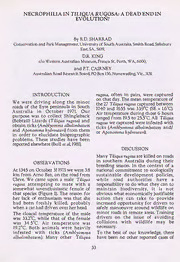
Necrophilia in Tiliqua rugosa: a dead end in evolution PDF
Preview Necrophilia in Tiliqua rugosa: a dead end in evolution
NECROPHILIA IN TILIQUA RUQOSA: A DEAD END IN EVOLUTION? By R.D. SHARRAD Conservation and Park Management, University of South Australia, Smith Road, Salisbury East, SA„ 5109, D.R. KING cl o Western Australian Museum, Francis St., Perth, WA., 6000, and P.T. CA1RNEY Australian Road Research Board, PO Box 156, Nunawading, Vic., 3131. INTRODUCTION rugosa, often in pairs, were captured on that day. The mean temperature of We were driving along the minor the 27 Tiliqua rugosa captured between roads of the Eyre peninsula in South 1040 and 1655 was 33.9°C (SE = 1.6°C). Australia in October 1971. Our Air temperature during those 6 hours purpose was to collect Shingleback ranged from 19.5 to 25.5°C. All Tiliqua (Bobtail) Lizards (Tiliqua rugosa) and rugosa we captured were infested with obtain ticks (Amblyomma albolimbatum ticks (Amblyomma albolimbatum and/ and Aponomma hydrosauri) from them or Aponomma hydrosauri). in order to elucidate biogeographic problems. These studies have been reported elsewhere (Bull et al, 1981). DISCUSSION Many Tiliqua rugosa are killed on roads in southern Australia during their OBSERVATIONS breeding season. In the context of a At 1345 on October 311971 we were 3.8 national commitment to ecologically km from Arno Bay, on the road from sustainable development policies, Cleve. We came upon a male Tiliqua while road authorities have a rugosa attempting to mate with a responsibility to do what they can to somewhat unenthusiastic female of maintain biodiversity, it is not that species (Figure 1). The reason for obvious what economically justifiable her lack of enthusiasm was that she action they can take to provide had been freshly killed, probably increased opportunity for drivers to when a car had driven over her head. safely manoeuvre around wildlife on minor roads in remote areas. Training The cloacal temperature of the male drivers on the issue of avoiding was 33.2°C, while that of the female collisions with wildlife may be was 34.5°C. Air temperature was necessary. 19.2°C. Both animals were heavily infested with ticks (Amblyomma To the best of our knowledge, there albolimbatum). Many other Tiliqua have been no other reported cases of 33 Figure 1. MaleShingleback attempting to mate with a recently dead female. necrophilia in Tiliqua rugosa in any previously (Lambiris 1966). The male circumstances. We therefore do not gave up and left the scene after three know whether or not this attempts when the dead female (not phenomenon is restricted to roadsides, surprisingly) failed to respond to him or how frequently it occurs. We do nuzzling along her hind legs and know that both of the participants in caressing her. The male returned after the incident we witnessed had cloacal a few hours and tried to court the temperatures within the range of dead female again, without success active animals captured that day, (Lambiris 1966). It is not known which may indicate some degree of whether the male had previously been temperature preference by the male. successful in copulating with the dead The time of death of the female is female. unknown. Although it’s growth has been The only other report of possible uneven, there is an increasing trend in necrophilia in reptiles of which we are road use (Australian Bureau of aware was of three unsuccessful Statistics 1982-1991). Increased traffic attempts at copulation in "Rhodesia" may result in increased reptile road (Zimbabwe) in September 1965 by a deaths, and hence increasing male Varanus albigularis with a female incidence of necrophilia amongst which had died a few hours reptiles. Whether this will be 34 sufficient to result in a significant REFERENCES change in the reproductive behaviour AUSTRALIAN BUREAU OF of any particular species of reptile or STATISTICS. 1982, 1985, 1988, 1991. not is unknown, but we feel Survey of Motor Vehicle Use. Australian confident in stating that its impact on Bureau of Statistics. the evolution of reproduction in BULL, C.M., SHARRAD, R.D. & reptiles will be nil. PETNEY, T. 1981. Parapatric boundaries in Australian Ticks. Ecol. Soc. Aust Sym. (Melbourne: May 1980). ACKNOWLEDGMENTS LAMB1R1S, A.J. 1966. Observations on We thank Jim Merchant and Inge Rhodesian reptiles. ]. herpet. ass. Africa. Newman for their scholarly assistance. 2: 33-34. 35
